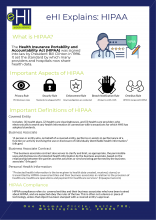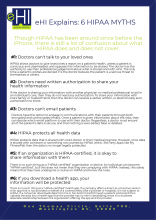CRISP is Pleased to Submit Comments to the Office of the National Coordinator for Health Information Technology (ONC) on the Proposed Rule 21st Century Cures Act
CRISP supports the proposed rule and strongly supports the direction ONC is taking with regards to interoperability.
eHI Explains: HIPAA

HIPAA Myths

Healthix Template for Qualified Service Organization Agreement (QSOA)
A Qualified Service Organization Agreement (QSOA) is a two-way agreement between a Part 2 program and the entity providing the service, for example a lab. The QSOA authorizes communication only between the Part 2 program and QSO.
This template was provided by Healthix, a NY HIE that presented on best practices of sharing sensitive PHI from 42CFR Part 2 Programs on eHI's April 30, 2019 webinar.
Did You Know The EEOC Enforces Complaints About Employers' Misuse of Genetic Information?
Did You Know The EEOC Enforces Complaints About Employers' Misuse of Genetic Information?
Many people know that the U.S. Equal Employment Opportunity Commission(EEOC) investigates claims of workplace discrimination related to an employee's race, gender, age, etc. But most of the public does not realize that the EEOC also enforces discrimination related to an employee's genetic information. To help spread the word, the information below is based upon the EEOC's guidance on this relatively new and far-reaching prohibition.
The EEOC investigates complaints under Title II of the Genetic Information Nondiscrimination Act of 2008 (GINA), which became effective in 2009. While the EEOC handles employment-related claims under GINA, the law also prohibits discrimination based on genetic information when it comes to insurance, over which the Departments of Labor, Health and Human Services, and Treasury have jurisdiction.
The full Forbes article can be viewed at this link.
What Does Healthcare Cybersecurity Look Like in a Future of Connected Medical Devices?
What Does Healthcare Cybersecurity Look Like in a Future of Connected Medical Devices?
As technology continues to transform the way healthcare is delivered, the industry is burdened by the growing cybersecurity risks inherent in the expansion of connected devices. Understanding that each connected device opens another pathway for threat actors, it’s incumbent upon device manufacturers to keep security foremost throughout the development life cycle.
The question is, how can manufacturers ensure the security of the devices they create? Furthermore, what can healthcare companies do to mitigate the risks inherent in the future of healthcare cybersecurity?
The full Security Intelligence article can be viewed at this link.
New, revised pain assessment/management standards for behavioral health care, home care, nursing care to be introduced
New, revised pain assessment/management standards for behavioral health care, home care, nursing care to be introduced
Effective July 1, 2019, new and revised pain assessment and management standards will be applicable to Joint Commission-accredited behavioral health care, home care and nursing care center programs.
The program-specific standards follow new and revised pain assessment and management requirements for hospitals, ambulatory health care organizations, critical access hospitals and office-based surgery practices that The Joint Commission introduced earlier this year.
To help health care organizations better understand and comply with the updated standards, The Joint Commission has released three new R3 Reports to provide in-depth rationale, references and evidence that guided the development of the new and revised requirements:
The updated standards were developed based on public field review and expert guidance from a technical advisory panel, program-specific expert panels and program-specific standards review panels. They are designed to provide contemporary guidance for pain assessment and management, as well as to strengthen organizations’ practices for pain assessment, treatment, education and monitoring.
The Joint Commission's news item and reports can be found at this link.
Consumerism Will Spark Change Across the Industry: My Top Seven Health IT Predictions for 2019
Consumerism Will Spark Change Across the Industry: My Top Seven Health IT Predictions for 2019
As we prepare to take on the challenges and opportunities of a new year, let’s lay out some of the industry’s macro trends and what they might mean to us in 2019.
This year, there is a theme. As patients, we have an increasingly consumer-oriented mindset—and rightfully so. We’re paying closer attention to the quality and value we’re getting for the money we’re spending. This “consumerization” of healthcare, along with constant technology innovation, is driving a tectonic shift across the industry, and it’s easy to be excited about what the future holds.
After nearly 40 years in this business, I’d better be getting good at reading between the lines to understand what’s coming next. So without further ado, here are my top seven health IT predictions for 2019.
- Consumerization of healthcare reaches tipping point
- Telehealth, mobility and millennials will upend the who and where of care delivery
- Consumers will demand healthcare price transparency
- People will insist on the ability to easily share their health data -- forcing the industry to accelerate interoperability solutions
- Increased interoperability will propel value-based care
- Initially driven by government regulations, the health IT industry will take the lead on battling the opioid epidemic
- The healthcare market will demand easier, more appropriate access to high cost specialty drugs
The full Surescripts article can be viewed at this link.
Medical Device Classification Procedures: Incorporating Food and Drug Administration Safety and Innovation Act Procedures
Medical Device Classification Procedures: Incorporating Food and Drug Administration Safety and Innovation Act Procedures
The Food and Drug Administration (FDA, the Agency, or we) is issuing a final rule to amend its regulations governing classification and reclassification of medical devices to conform to the applicable provisions of the Federal Food, Drug, and Cosmetic Act (FD&C Act) as amended by the Food and Drug Administration Safety and Innovation Act (FDASIA). FDA is also making additional changes unrelated to the FDASIA requirements, to update its regulations governing the classification and reclassification of medical devices. FDA is taking this action to codify the procedures and criteria that apply to the classification and reclassification of medical devices and to provide for classification of devices in the lowest regulatory class consistent with the public health and the statutory scheme for device regulation.
The full pdf can be downloaded below.
Statement from FDA Commissioner on transformative new steps to modernize FDA’s 510(k) program to advance the review of the safety and effectiveness of medical devices
Statement from FDA Commissioner on transformative new steps to modernize FDA’s 510(k) program to advance the review of the safety and effectiveness of medical devices
Forty-two years ago, Congress passed the law establishing the framework for evaluating the safety and effectiveness of medical devices. Today, we’re announcing changes to modernize the FDA’s 510(k) clearance pathway, which accounts for the majority of devices that the FDA reviews. We’re pursuing these changes to help keep pace with the increasing complexity of rapidly evolving technology. The new technology that we’re seeing holds tremendous public health promise for patients. But with the advances also come new complexities that can make the review of safety and effectiveness more challenging. The framework we propose is aimed at efficiently advancing beneficial technology to patients, while solidifying FDA’s gold standard for safety.
We believe that where appropriate, new medical devices that come to market under the 510(k) pathway should either account for advances in technology or demonstrate that they meet more modern safety and performance criteria. We want to make sure that new devices are evaluated against advances in technology that can improve patient safety and performance. In making these reviews, where appropriate, we want to rely on modern safety and performance criteria. At the same time, we’re going to pursue additional actions that will allow the FDA to retire outdated predicates, especially in cases where we’ve seen safer or more effective technology emerge.
We believe firmly in the merits of the 510(k) process. But we also believe that framework needs to be modernized to reflect advances in technology, safety and the capabilities of a new generation of medical devices. In short, we believe that it’s time to fundamentally modernize an approach first adopted in 1976, when Congress considered the vast diversity of devices that would become subject to the FDA’s regulatory oversight and established many of the predicate devices that served as the basis for 510(k) clearances during the last 40 years.
The full press announcement can be found at this link.
